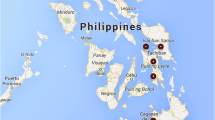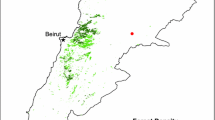Abstract
This paper reviews forestry seedling production systems in South-east and East Asia and identifies problems with respect to seedling quality, seedling distribution and financial sustainability, and measures which have been adopted or advocated to improve performance in this sector. The paper draws in particular on experience in a series of research projects on smallholder forestry in the Philippines. Some observations are also drawn from the following papers in this combined special issue of Small-scale Forestry. It is found that a mix of public and private sector models are adopted for forestry seedling production, between and even within countries. Often nurseries are set up to provide seedlings for a government-directed expansion in tree planting, and have difficulty surviving once the initial planting purpose is completed. Private nurseries often lack resources, and depend on contracts to supply seedlings for financial viability. Demand tends to be highest for fast-growing species (often exotics), fruit trees, and ornamentals in the case of urban nurseries. Government policies typically favour quantity over quality of the seedlings produced. Considerable scope exists for adopting best or at least improved management practice in seedling nurseries.
Similar content being viewed by others
Notes
Byron’s other three keys are: secure property rights to land and tree crops; capacity for crop protection; and adequate markets.
According to the Global Warming is Real (2008), Indonesian officials on 28 November 2007 reported that 79 million trees were planted in a single day in an effort to replant lost forest cover and signal how seriously the government views the problem of climate change. This took place shortly before the United Nations climate change conference in Bali of 3–14 December. NPR Foundation (2008) noted that the move is part of a United Nations campaign to plant a billion trees around the world.
Formally, this is ACIAR project ASEM/2006/091—Enhancing tree seedling supply via economic and policy changes in the Philippines nursery sector.
As defined by Helms (1998), a superior tree is one having ‘Genetics phenotypically better than the average of the population but not yet tested for genetic worth …’ (p. 180), a plus tree is ‘A tree selected on the basis of its outstanding phenotype but not yet clonally or progeny tested …’ (p. 138), and the term elite applies to ‘A tree, stand or group of genotypes verified by appropriate testing as being genetically superior or desirable for a specified environment and propagation system. …’ (p. 55).
References
Byron RN (2001) Keys to smallholder forestry in developing countries in the tropics, Chap. 16. In: Harrison SR, Herbhn JL (eds) Sustainable farm forestry in the tropics: social and economic analysis and policy. Edward Elgar, Cheltenham
DENR (Department of Environment, Natural Resources) (2003) Non-mist clonal multiplication of dipterocarps. Ecosystems Research and Development Bureau, College, Laguna
Department of Forestry and DANIDA (2007) Essential documents on management and technologies for forest reproductive materials in Vietnam. Vietnam Tree Seed Project, Ministry of Agriculture and Rural Development, Hanoi
Estoria E, Herbohn JL, Harrison SR (2004) The performance of community organisers in promotion of community forestry in Leyte Province Philippines. Small-Scale For Econ Manage Policy 3(3):363–384
Foundation NPR (2008) Indonesia embarks on tree-planting campaign. http://www.npr.org/templates/story/story.php?storyId=16686552. Accessed 22 May 2008
Global Warming is Real (blog site, 2008) Mass tree planting in Indonesia. http://www.globalwarmingisreal.com/blog/2007/11/28/mass-tree-planting-in-indonesia/. Accessed 22 May 2008
Gregorio N (2006) Improving the effectiveness of the forest nursery industry in Leyte Province, The Philippines. PhD thesis, The University of Queensland, Brisbane
Gregorio NO, Herbohn JL, Harrison SR (2004a) The social and economic factors affecting the role that nurseries play in efficient forestry development in Leyte, the Philippines. In: Baumgartner D (ed) Proceedings of human dimensions of farm, family and community forestry international symposium, March 28–April 2004, Washington State University, Pullman, WA, USA. Washington State University Extension MISC0526, pp 113–118
Gregorio N, Herbohn J, Harrison S (2004b) Small-scale forestry development in Leyte, Philippines: the central role of nurseries. Small-Scale For Econ Manage Policy 3(3):337–352
Gregorio NO, Herbohn JL, Harrison SR (2005) Small-scale forestry development in Leyte, The Philippines: the central role of nurseries. ACIAR Smallholder Forestry Project ASEM/2000/088 Redevelopment of a Timber Industry following Extensive Land Clearing. Proceedings from the end-of-project workshop held in Ormoc City, The Philippines, 19–21 August 2004, pp 243–256
Harrison SR, Herbohn JL (2003) Strategies for forest industry redevelopment in Leyte. Asia Pacific J Environ Dev 10(1):13–27
Harrison SR, Gregorio NO, Dargusch P (2008a) Report of visits to seedling nurseries in Indonesia, Thailand and Vietnam. ACIAR seedling enhancement project, The University of Queensland, Brisbane
Harrison S, Gregorio N, Herbohn J, Mercado A Jr (2008b) Seedling production systems for smallholder forestry development: local practices versus national policies in the Philippines. Paper presented at the International symposium on small-scale rural forest use and management: global policies versus local knowledge Gérardmer, France, 23–27 June 2008
Helms JA (ed) (1998) The dictionary of forestry. The Society of American Foresters and CABI Publishing, Wallingford
Killin DR, Herbohn JL, Harrison SL (2002) A ‘cluster’ approach to private forest industry development in the wet tropics of far north Queensland, Australia. Paper presented at the Conference of the Environment Institute of Australia, Brisbane
MARD (Ministry of Agriculture, Rural Development) (2006) Decision on approval of the forest reproductive materials development strategy for 2006–2020. Socialist Republic of Vietnam, Hanoi
Nasayao E (2007) Enhancing tree seedlings via economic and policy changes in the philippine forest nursery sector. Paper presented at the Second Region 8 forest policy workshop on ‘improving financial returns to smallholder tree farmers in the Philippines’. DENR Region 8 Multipurpose Hall, Tacloban City, Leyte, September 20, 2007
Roshetko JM, Mulawarman, Dianarto A (2004) Tree seed procurement-diffusion pathways in Wonogiri and Ponorogo, Java: Indonesia’s main source of tree seed. ICRAF Southeast Asia Working Paper, No. 2004-1, Bogor, Indonesia
Sy MU (1998) Rehabilitation of natural logged-over forests: the Philippines scenario. Canopy International, November–December, pp 3, 9–11
Author information
Authors and Affiliations
Corresponding author
Rights and permissions
About this article
Cite this article
Harrison, S., Gregorio, N. & Herbohn, J. A Critical Overview of Forestry Seedling Production Policies and Practices in Relation to Smallholder Forestry in Developing Countries. Small-scale Forestry 7, 207–223 (2008). https://doi.org/10.1007/s11842-008-9051-5
Received:
Accepted:
Published:
Issue Date:
DOI: https://doi.org/10.1007/s11842-008-9051-5




